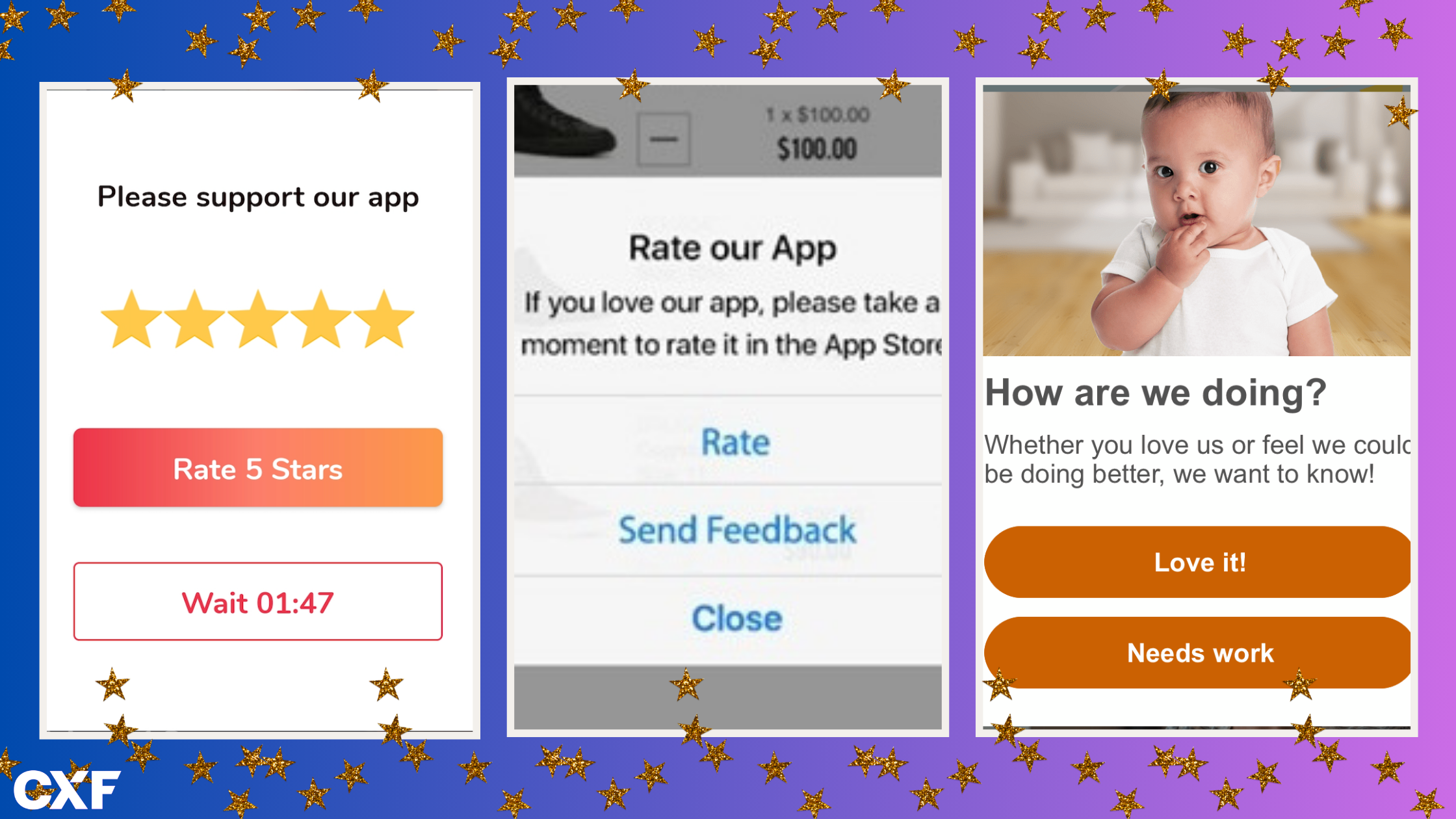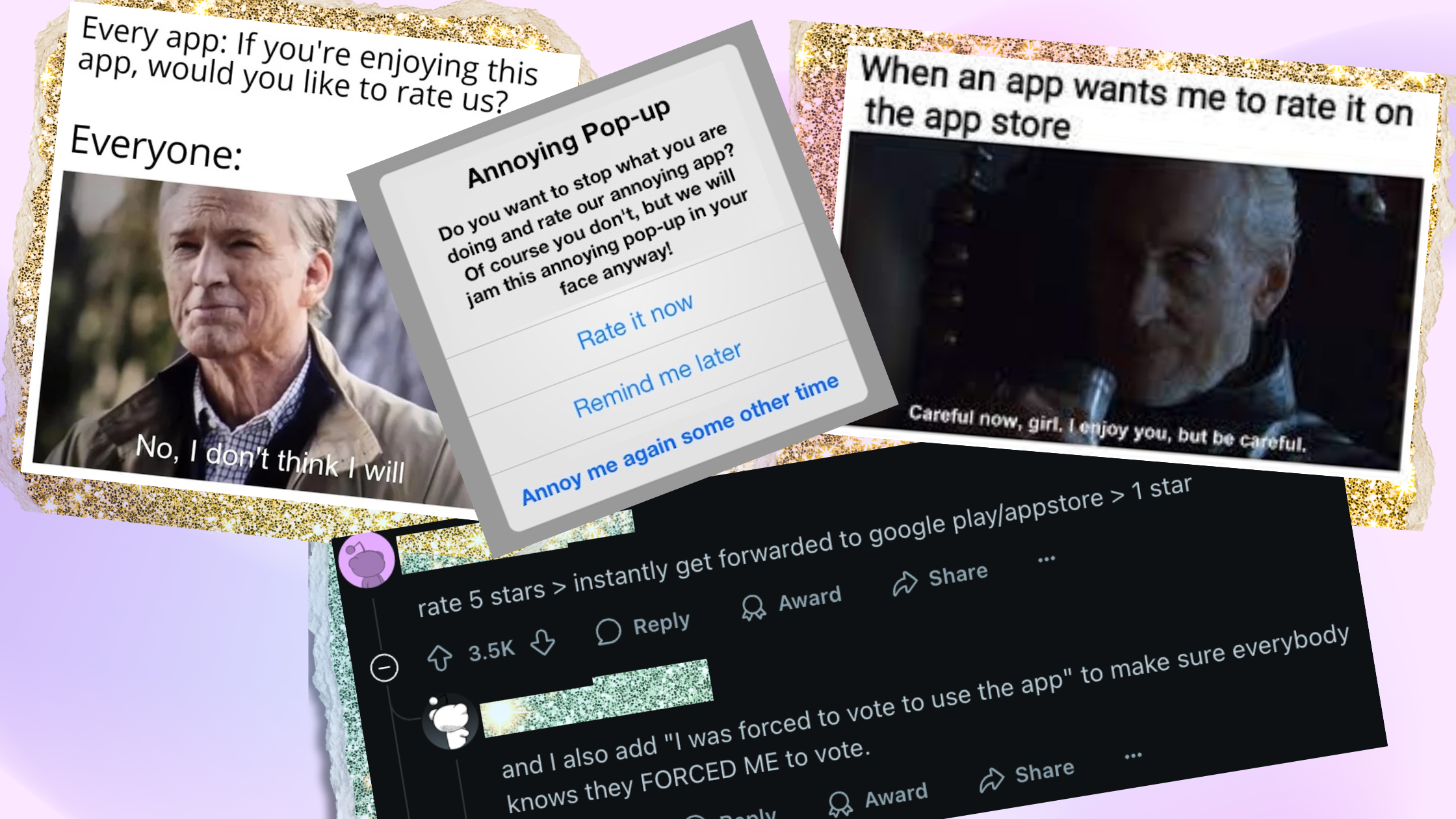August 26, 2025 • 6 min read
Forced Feedback: Why In-App Review Requests Lead To One-Star Reviews

CX Analyst & Thought Leader
August 26, 2025

A few weeks ago, I used a popular event planning app to help my fiance and I organize a casual wedding send-off celebration. The app has a much cooler design than its starched-collar competitors, doesn’t try to sell me on premium features, and genuinely makes the party planning process much less stressful.
In over a year of using the app, I’d never had a bad experience. I liked it so much that I recommended it to all my family and friends. I was a loyal customer and an active promoter. If it had been collected, my CSAT score would have been through the roof.
And then. In the middle of planning this pre-wedding party, right as I’m typing up detailed directions for guests, I get a random pop up that takes over my entire screen:
“ARE YOU ENJOYING USING THIS APP? TAP A STAR TO RATE IT ON THE APP STORE.”

My first thought: Well, I was!
I couldn’t continue using the app unless I provided some kind of a response. This annoyed me for several reasons:
- I was interrupted
- I was unable to return to what I was doing unless I responded
- I was being forced to provide feedback on someone else’s schedule, not my own. It felt like someone asking you for a favor at the worst possible time
- I didn’t know if this poorly-timed pop-up meant I’d now lost all the information I’d just spent 20 minutes typing into the event description
- Even if I’d wanted to provide feedback, doing so would have automatically directed me to another app, causing further disruption
So what did I, a customer that previously had only sung the praises of this app, do?
I gave the app one star. And I liked doing it.
In a way, it felt like revenge: You interrupt my experience, I trash you on the app store.
Why Customers Absolutely Hate In-App Review Requests
While I wouldn’t say my gleeful schadenfreude gives me the moral high ground, I will say that it’s a sentiment shared by, seemingly, the entire internet.

The general customer consensus is that in-app pop-up review requests are annoying, inconvenient, intrusive, and disruptive. Customers say they’re already constantly bombarded with review requests from other apps. Many see automated review requests as little more than a brand’s attempt to hack their way into ranking higher in the app store. They don’t believe for a second that in-app review requests are born from a genuine interest in understanding and improving customer experience.
Particularly savvy customers are also aware of how self-selection or acquisition bias skew app review results, over-emphasizing positive or negative extremes. Then there’s the framing bias, when surveys only ask about one specific aspect of the user experience–one they already know customers like.
One of the biggest frustrations is that customers report still getting in-app review requests even after blocking the system prompts in their mobile settings. To me, that’s akin to companies that continue to call leads even though they’re on the Do Not Call list.
Here’s the takeaway: even if your app is free, and even if you feel like customers “owe” you a review in exchange for continued app access, the reality is that your customers hate in-app review requests–and are very likely to take out that frustration in the form of a one-star rating.
The App Review Catch-22
There’s no denying the importance of customer reviews: in the app store, on social media, and on review websites like Google or Yelp. 95% of consumers read online reviews, and 59% read two or more online reviews before making a buying decision. 31% spend more on businesses or products with positive reviews.[*]
Clearly, online reviews have a huge influence over app use, consumer trust, and customer conversions.
But while almost all customers read existing app reviews before download, far fewer are willing to leave reviews themselves. In 2025, the average customer survey response rate sits at just 33%.[*] In-app survey response rates are even lower, with an average response rate of 25% and an average completion rate of 23%.[*]
App developers are stuck in a catch-22: they need reviews–and lots of them–to be seen, but customers aren’t writing them. It’s a natural progression to force customers to leave reviews via in-app pop-ups, especially in an era many CX analysts describe as a “customer feedback crisis.”
But, much like my gleeful 1-star review of an app I actually like, the natural instinct isn’t always the right one.
In-App Review Requests: Best Practices + Alternatives
No matter how much in-app reviews frustrate customers, they still understand that businesses depend on customer feedback to be seen, gain credibility, and survive. While I’d love to continue using an app without ever being asked for anything in return, I know that dream will never, ever come true.
I don’t mind leaving customer feedback for apps I like. But there are more convincing ways to convince customers to leave genuine and valuable feedback in the app store aside from forcing their hands.
That said, for many apps (and businesses in general) in-app review requests are the main source of customer feedback. If you must continue to them, then at least review these best practices for successful, non-annoying in-app review requests:
- Acknowledge that the review request is a disruption.
- Vary review request prompts and survey type–don’t keep making users answer the same questions or review one aspect of your app over and over again. Include a mix of review requests, NPS and CSAT surveys, open-ended questions, and star rankings.
- Don’t send review requests at random intervals. Instead, send them out based on user engagement levels or after key milestones.
- Customers want to know why they’re being asked to provide feedback, and what’s in it for them if they do. Make your case in one sentence or less, and include that sentence directly underneath the question prompt.
- Let customers know if completing a review requires a re-direction to another application, like the app store. Whenever possible, keep the user in the app interface.
- Refrain from prompting users to leave an app review for at least 30 days after they’ve declined once, and for at least 90 days after they’ve left a review/provided other feedback.
- Stick to one question at a time. No one wants an in-app survey that both interrupts the task at hand AND takes forever to complete.
- Word your survey questions simply. This isn’t the time for flowery language, and it’s certainly not the time for intentionally confusing or deceptive language that tries to make customers respond a certain way.
- Make review request pop-ups visually appealing. Include your brand colors, easy-to-read fonts, and emojis or icons to increase engagement.
- Thank customers for their participation, and let them know their response has been received. If possible, send a personalized follow-up based on user responses.